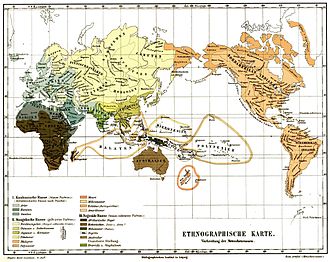Mongoloid (race)

| Caucasoid: Aryans Semitic Hamitic Negroid: African Negro Khoikhoi Melanesian Negrito Australoid Uncertain: Dravida & Sinhalese | Mongoloid: North Mongol Chinese & Indochinese Korean & Japanese Tibetan & Burmese Malay Polynesian Maori Micronesian Eskimo & Inuit American |
Mongoloid was a word for a person from East Asia, Southeast Asia, the Arctic, the Americas or the Pacific Islands. The group of these persons was called Mongoloid race. In former times, many people divided human beings into three races. These races were called Mongoloid, Caucasoid, and Negroid. Today, scientists agree that there is only one human race. Modern genetic research has shown that the idea of three races was wrong.[1][2]: Script error: The function "hyphen2dash" does not exist. 
German anthropologists invented the name Mongolian race in the 18th century. Later, the name changed to Mongoloid. This means "looking like a Mongol".
The word "mongoloid" was once also used to mean a person with Down syndrome. This was an offensive term (an insult) because people said it was like "Mongolian idiocy" or "Mongolian imbecility". Down syndrome has nothing to do with the Mongoloid race: it is a genetic condition found in all types of humans.
Mongoloid (race) Media
References
- ↑ American Association of Physical Anthropologists (27 March 2019). "AAPA Statement on Race and Racism". American Association of Physical Anthropologists. Archived from the original on 22 March 2020. Retrieved 19 June 2020.
- ↑ Templeton, A. (2016). EVOLUTION AND NOTIONS OF HUMAN RACE. In Losos J. & Lenski R. (Eds.), How Evolution Shapes Our Lives: Essays on Biology and Society (pp. 346-361). Princeton; Oxford: Princeton University Press. . That this view reflects the consenus among American anthropologists is stated in: Wagner, Jennifer K.; Yu, Joon-Ho; Ifekwunigwe, Jayne O.; Harrell, Tanya M.; Bamshad, Michael J.; Royal, Charmaine D. (February 2017). "Anthropologists' views on race, ancestry, and genetics". American Journal of Physical Anthropology. 162 (2): 318–327. doi:10.1002/ajpa.23120. PMC 5299519. PMID 27874171.
